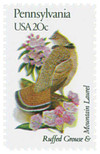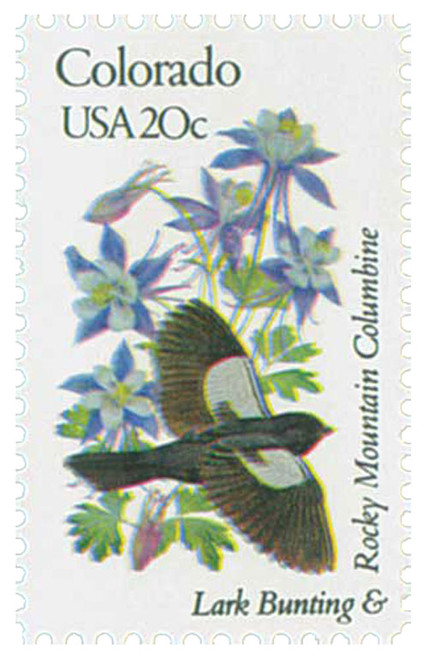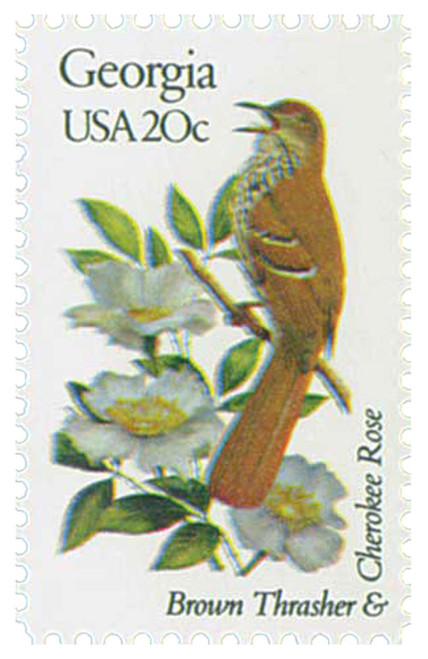
# 1990 - 1982 20c Pennsylvania State Bird & Flower
20¢ Pennsylvania
State Birds and Flowers
City: Washington, DC and state capitals
Quantity: 13,339,000 panes
Printed By: Bureau of Engraving and Printing
Printing Method: Photogravure
Perforations: 10.5 x 11.25
Color: Multicolored
Pennsylvania Becomes 2nd State

On December 12, 1787, Pennsylvania was the second state to ratify the Constitution and be admitted to the Union.
Two major Indian tribes lived in Pennsylvania when the first European explorers arrived – the Algonquian and the Iroquoian. The Algonquian tribes included the Conoy, Delaware, Nanticoke, and Shawnee. Only one Iroquoian tribe lived in the region, the Susquehannock, who lived along the Susquehanna River.
Henry Hudson, an English explorer working for the Dutch East India Company, sailed into Delaware Bay looking for a trade route to the Far East. Hudson’s reports on the region led the Dutch to send more explorers, and in 1615, Cornelius Hendricksen sailed the Delaware up to what is now Philadelphia.
However, it was the Swedes who made the first permanent settlement in the region. In 1643, they made Tinicum Island, near Philadelphia, the capital of the colony of New Sweden. Dutch troops led by Peter Stuyvesant came from New Netherland and captured New Sweden in 1655. The Dutch controlled the region until 1664, when the English assumed control. The Duke of York governed until 1681, when King Charles II gave this land to William Penn to pay a debt he owed his father, an English admiral. Penn wanted to name the region New Wales, but was blocked by a powerful Welsh member of the Privy Council. So, Penn settled on the name Sylvania, which means woods. King James II added Penn to the name in honor of William’s father.

As a Quaker, William Penn wanted the people of Pennsylvania to have freedom to worship, as well as personal and political freedoms. He arrived in Pennsylvania in 1682 with the colony’s first constitution, the Frame of Government, which he had written. It provided for a deputy governor and an elected legislature with a provincial council and a general assembly. In 1683, the legislature drafted a second Frame of Government, which gave the people even more power. Shortly after he arrived, Penn paid the Indians in the region for the land King Charles had given him – even though he was not obligated to do so. Penn was removed as governor of the colony for a short time when his daughter, Mary, and her husband, William,
Pennsylvania, and particularly Philadelphia, was a hotbed for revolutionary patriots. The First Continental Congress met in Philadelphia on September 5, 1774. This congress voted to stop all trade with Great Britain. The Revolutionary War began in April 1775. The next month, the Second Continental Congress met in Philadelphia. The delegates there voted for independence. This resulted in the adoption of the Declaration of Independence on July 4, 1776, in the Pennsylvania Statehouse (now Liberty Hall) in Philadelphia. The state’s first convention was held in the State House at that time..
Pennsylvania was known as a leader in the iron and grain milling industries as early as 1750. After the Revolutionary War, the state continued to modernize and increase its industrial growth. John Fitch demonstrated America’s first workable steamboat on the Delaware River near Philadelphia in 1787. Robert Fulton launched a steamboat in Pittsburgh in 1811. It was the first to travel the Ohio and Mississippi rivers. The first long canal in the U.S., the Schuykill Canal, was built between Philadelphia and Reading in 1825. The next year, the state started building the Pennsylvania Canal System. By 1834, Philadelphia and Pittsburgh were linked by canals and railroads. In 1859, Edwin Drake drilled the nation’s first commercially successful oil well near Titusville.
After the Civil War, Pennsylvania prospered. The state’s existing agricultural, lumber, and mining industries continued to grow. It also became a leading producer of oil, cement, electrical equipment, and aluminum. Pittsburgh became the nation’s leading producer of steel. This growth continued into the 1900s, stalled during the Great Depression, and then resumed with the start of World War II (1939-45).

During the 1970s and 1980s, foreign competition and other problems led to a decline of the state’s steel-making industry. Although it remains one of the nation’s leading steel producers, Pennsylvania began shifting from industrial and manufacturing activities to educational, financial, service, and technology-based industries. Larger cities like Philadelphia, Pittsburgh, and Allentown have led these economic changes.
Pennsylvania has also focused on restoring and preserving many of its historical sites and buildings, especially in Philadelphia and Pittsburgh. This work has increased tourism and created thousands of new jobs.
20¢ Pennsylvania
State Birds and Flowers
City: Washington, DC and state capitals
Quantity: 13,339,000 panes
Printed By: Bureau of Engraving and Printing
Printing Method: Photogravure
Perforations: 10.5 x 11.25
Color: Multicolored
Pennsylvania Becomes 2nd State

On December 12, 1787, Pennsylvania was the second state to ratify the Constitution and be admitted to the Union.
Two major Indian tribes lived in Pennsylvania when the first European explorers arrived – the Algonquian and the Iroquoian. The Algonquian tribes included the Conoy, Delaware, Nanticoke, and Shawnee. Only one Iroquoian tribe lived in the region, the Susquehannock, who lived along the Susquehanna River.
Henry Hudson, an English explorer working for the Dutch East India Company, sailed into Delaware Bay looking for a trade route to the Far East. Hudson’s reports on the region led the Dutch to send more explorers, and in 1615, Cornelius Hendricksen sailed the Delaware up to what is now Philadelphia.
However, it was the Swedes who made the first permanent settlement in the region. In 1643, they made Tinicum Island, near Philadelphia, the capital of the colony of New Sweden. Dutch troops led by Peter Stuyvesant came from New Netherland and captured New Sweden in 1655. The Dutch controlled the region until 1664, when the English assumed control. The Duke of York governed until 1681, when King Charles II gave this land to William Penn to pay a debt he owed his father, an English admiral. Penn wanted to name the region New Wales, but was blocked by a powerful Welsh member of the Privy Council. So, Penn settled on the name Sylvania, which means woods. King James II added Penn to the name in honor of William’s father.

As a Quaker, William Penn wanted the people of Pennsylvania to have freedom to worship, as well as personal and political freedoms. He arrived in Pennsylvania in 1682 with the colony’s first constitution, the Frame of Government, which he had written. It provided for a deputy governor and an elected legislature with a provincial council and a general assembly. In 1683, the legislature drafted a second Frame of Government, which gave the people even more power. Shortly after he arrived, Penn paid the Indians in the region for the land King Charles had given him – even though he was not obligated to do so. Penn was removed as governor of the colony for a short time when his daughter, Mary, and her husband, William,
Pennsylvania, and particularly Philadelphia, was a hotbed for revolutionary patriots. The First Continental Congress met in Philadelphia on September 5, 1774. This congress voted to stop all trade with Great Britain. The Revolutionary War began in April 1775. The next month, the Second Continental Congress met in Philadelphia. The delegates there voted for independence. This resulted in the adoption of the Declaration of Independence on July 4, 1776, in the Pennsylvania Statehouse (now Liberty Hall) in Philadelphia. The state’s first convention was held in the State House at that time..
Pennsylvania was known as a leader in the iron and grain milling industries as early as 1750. After the Revolutionary War, the state continued to modernize and increase its industrial growth. John Fitch demonstrated America’s first workable steamboat on the Delaware River near Philadelphia in 1787. Robert Fulton launched a steamboat in Pittsburgh in 1811. It was the first to travel the Ohio and Mississippi rivers. The first long canal in the U.S., the Schuykill Canal, was built between Philadelphia and Reading in 1825. The next year, the state started building the Pennsylvania Canal System. By 1834, Philadelphia and Pittsburgh were linked by canals and railroads. In 1859, Edwin Drake drilled the nation’s first commercially successful oil well near Titusville.
After the Civil War, Pennsylvania prospered. The state’s existing agricultural, lumber, and mining industries continued to grow. It also became a leading producer of oil, cement, electrical equipment, and aluminum. Pittsburgh became the nation’s leading producer of steel. This growth continued into the 1900s, stalled during the Great Depression, and then resumed with the start of World War II (1939-45).

During the 1970s and 1980s, foreign competition and other problems led to a decline of the state’s steel-making industry. Although it remains one of the nation’s leading steel producers, Pennsylvania began shifting from industrial and manufacturing activities to educational, financial, service, and technology-based industries. Larger cities like Philadelphia, Pittsburgh, and Allentown have led these economic changes.
Pennsylvania has also focused on restoring and preserving many of its historical sites and buildings, especially in Philadelphia and Pittsburgh. This work has increased tourism and created thousands of new jobs.

















